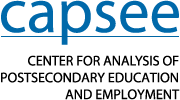How Free College Can Affect You Later in Life | 8/31/2016
MarketWatch writes about a new NBER study in which Judith Scott-Clayton explores how a scholarship program in West Virginia affects students’ economic success later in life.
What’s the Right Public Message About Going to College? | 8/30/2016
The Chronicle of Higher Education writes about the complexities in college outcomes, citing CAPSEE research by Judith Scott-Clayton.
By: Judith Scott-Clayton & Basit Zafar | National Bureau of Economic Research | August 2016
In this paper, the authors utilize two complementary quasi-experimental strategies to identify causal effects of the WV PROMISE scholarship, a broad-based state merit aid program, up to 10 years post-college-entry.
Using North Carolina data, this study analyzes the employment and earnings outcomes for different community college pathways and awards. Outcomes for this project include employment (e.g., industry and occupation), patterns of employment and unemployment, and earnings.
Using Michigan data, this study aimed to estimate the employment and earnings returns to course credits and the additional returns to a credential or degree, and to examine variation in outcomes by program and course content and student characteristics.
In this study, the research team examined the college enrollment, persistence, and educational and employment outcomes of Ohio students by using state administrative data matched with employment records.
This study used Virginia data to relate educational pathways to the industry and occupation of employment, patterns of employment, earnings, and occupational outcomes, and to assess the labor market returns to developmental education.
CAPSEE’s research in California consisted of two studies. The first analyzed returns to career and technical education (CTE) pathways; the second analyzed general returns to awards, coursework/subjects, and credits from enrollment in California community colleges.
This analysis of national datasets examined the relative size and importance of the for-profit sector and compared education and labor market outcomes for those attending for-profit institutions versus similar students attending public institutions.
This project used national survey data to examine the correlation between educational attainment and patterns of interstate mobility, how mobility evolves over time, and the potential bias in estimating returns using single-state employment data.
